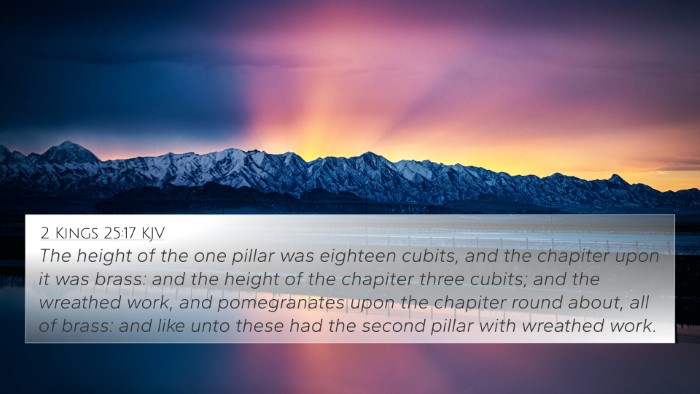Understanding 1 Kings 7:18
1 Kings 7:18 states: "And he made the pillars; and two rows round about upon the one network, to cover the chapiters that were upon the top of the pillars: and he did likewise to the other chapiter."
This verse describes an intricate detail in the construction of the pillars in Solomon's temple, focusing on the decorative aspects and craftsmanship involved. The verse highlights the architectural magnificence and the attention to aesthetic detail that characterized Solomon's reign.
Commentary Insights
Matthew Henry's Commentary
Henry emphasizes the importance of beauty in worship and how the structures built for God's dwelling place reflected not only functionality but also the excellence of craftsmanship. He notes that Solomon's attention to the finer points of design serves as a reflection of God's glory and majesty, indicating that our offerings to God should be of the highest standard.
Albert Barnes' Notes
Barnes points out that the two rows of nets mentioned were likely elaborate adornments that demonstrated the fusion of beauty and utility. He connects this detail to the broader theme of how God's house should be a place that inspires awe and reverence. The significance of the pillars is not only in their physical structure but also in their symbolic representation of strength and stability in faith.
Adam Clarke's Commentary
Clarke remarks on the technical aspects of the construction, indicating that the architectural features weren't merely practical but rather made to evoke splendor. This attention to design, he notes, serves as a parallel to how the inner life of a believer should reflect the glory of God through good works and righteousness.
Bible Cross-References
- Exodus 25:10-22 - Specifications for the construction of the Ark of the Covenant.
- 2 Chronicles 3:15-17 - Further account of the temple's pillars and decorations.
- 1 Kings 6:20-22 - Description of the inner sanctuary and its furnishings.
- Isaiah 28:16 - Symbolic reference to a cornerstone, reflecting strength.
- Psalm 127:1 - "Unless the Lord builds the house, those who build it labor in vain."
- 1 Peter 2:5 - Believers are living stones, being built into a spiritual house.
- 1 Corinthians 3:9 - "For we are God's fellow workers; you are God's field, God’s building."
- Hebrews 3:3-4 - Christ is considered worthy of greater honor than Moses, as the builder of God's house.
- Revelation 21:18 - The New Jerusalem's walls are built with precious stones.
- John 2:19-21 - Jesus refers to His body as the temple, emphasizing the significance of God dwelling among His people.
Thematic Connections
The construction of the temple and its pillars can be seen as a thematic representation of God's dwelling among His people. This theme resonates through various scriptures that discuss God's desire to abide with humanity, the importance of holiness, and the splendor of divine presence.
Comparative Bible Verse Analysis
When considering 1 Kings 7:18 in light of other similar scriptures, one can note the inter-Biblical dialogue that occurs regarding the themes of construction, beauty, and worship. For instance, the detailed descriptions in Exodus regarding the Tabernacle point toward an established protocol for God’s presence among His people, which carries into the more permanent structure of the Temple under Solomon.
The references to architecture in the Bible remind believers of their own spiritual lives. Just as Solomon put careful consideration into the physical attributes of the Temple, believers are called to build their lives on a foundation of faith, with beauty and holiness reflecting the character of Christ.
Using Tools for Bible Cross-Referencing
For those looking to deepen their understanding of connections between Bible verses, several tools for Bible cross-referencing are available. Utilizing a Bible concordance or a dedicated Bible cross-reference guide can aid in exploring themes and connections effectively. Understanding how verses relate helps uncover deeper meanings and encourages a more profound engagement with the text.
Employing cross-reference Bible study methods can aid believers in identifying links between the Old and New Testament and examining the intricate weavings of God's narrative throughout scripture. These connections illuminate God's continual communication with humanity, showing how His plans unfold over time.







